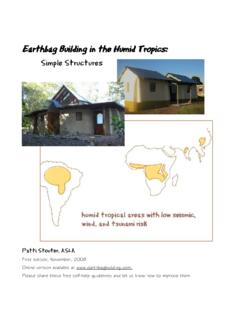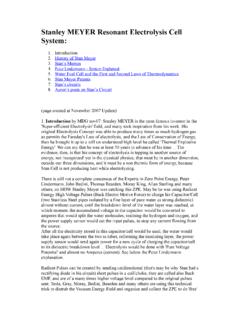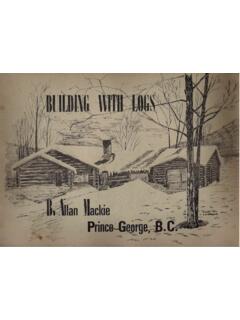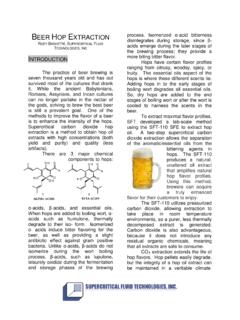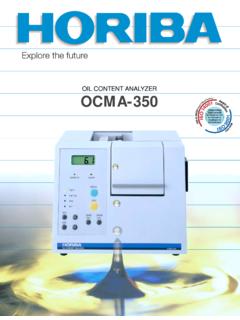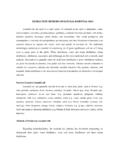Transcription of Oil Extraction - Rivendell Village
1 OIL Extraction Oil is extracted from several seeds, nuts and fruits (Table 1 provides some common examples) for use in cooking and soapmaking1, cosmetics, detergents, or as an ingredient in other foods such as baked or fried goods. Moisture content (%) Oil/fat content (%) Seeds and beans Cotton Rape Mustard Sesame Sunflower Safflower 5 9 7 5 5 5 15-25 40-45 25-45 25-50 25-50 30 Nuts Coconut (fresh) Copra Groundnut (shelled) Palm kernel nuts (shelled) Shea nut Shea nut 40-50 3 4 - - - - 35-40 64-70 28-55 - 46-57 34-44 - Fruits Oil palm Avocado Olive - 69 50-70 56 11-28 - Table 1: Sources of oil. Raw material preparation Oilseeds and nuts should be properly dried before storage, and cleaned to remove sand, dust, leaves and other contaminants. Fruits should be harvested when fully ripe, cleaned and handled carefully to reduce bruising and splitting. All raw materials should be sorted to remove stones and mouldy nuts. Some moulds, especially in the case of groundnuts, can cause aflatoxin poisoning.
2 When storage is necessary, this should be in weatherproof, ventilated rooms which are protected against birds, insects and rodents. Some raw materials (for example groundnuts, sunflower seeds) need dehusking (or decorticating). Figure 1 shows a simple manually-operated groundnut decorticating machine. Decortication is important to give high yields of oil and reduce the bulk of material to be processed. However, expellers normally require a proportion of fibrous material in order to work and, particularly with groundnuts, some husk is normally added to allow oil to escape more freely from the press. Coconut is dehusked and split manually by skilled operators. Most oilseeds (eg copra, palm kernels and groundnuts) need grinding in mills before oil Extraction to increase the yield of oil. A separate Technical Brief provides details of coconut processing. 1 See Technical Brief: Soapmaking . Figure 1: A groundnut decorticating machine Figure 2: A seed scorcher Oil Extraction Practical Action Some seeds (especially groundnuts for example) are conditioned by heating to 80-90oC using a seed scorcher (Figure 2 shows a typical small-scale example a separate heat source is necessary beneath the scorcher).
3 All oil-bearing materials need to have the correct moisture content to maximise the oil yield. Using small-scale expellers, oilseeds and nuts are usually processed cold (ie without additional heating). Oil Extraction Methods Extraction methods include: Manual presses Ghani Expeller Solvent Extraction Traditional methods Oil is extracted from, for example, fresh coconut, olive, palm fruit shea nut by separating the flesh and boiling it in water. Salt can be added to break any emulsion which is commonly formed and the oil is skimmed from the surface. In palm oil processing the fruit is first heated in a digester . Figure 3: A manual coconut grater Manual methods Oil can be extracted by pressing softer oilseeds and nuts, such as groundnuts and shea nuts, whereas harder, more fibrous materials such as copra and sunflower seed can be processed using ghanis. Pulped or ground material is loaded into a manual or hydraulic press to squeeze out the oil-water emulsion.
4 This is more efficient at removing oil than traditional hand squeezing, allowing higher production rates. Fresh coconut meat is removed from the shell using a manual or motorised grater (Figure 3). See Technical Brief on Coconut Processing for details of wet processing of coconuts. Equipment required The equipment needed to set up a small or medium scale oil Extraction enterprise falls into four main categories: pre- Extraction equipment; dehullers or decorticators, seed/kernel crackers, roasters, grinding mills. Extraction equipment; ghani, manual bridge press or ram press, expellers equipment for basic refining of the oil; filters, settling tanks for caustic soda to treat free fatty acids FFA (do not use aluminium tanks). packaging equipment. The specific equipment required will depend on the particular crop being processed, the final oil quality required and the scale of operation. Presses have a number of different designs, commonly based on a bridge press.
5 In all types, a batch of raw material is placed in a heavy-duty perforated metal cage and pressed by the movement of a plunger. The amount of material in the cage varies from 5-30 kg with an average of 20 kg. Layer plates can be used in larger cages to provide a constant pressure through the bulk of 2 Oil Extraction Practical Action material and speed up removal of oil. The pressure should be increased slowly to allow time for the oil to escape. Screw types are more reliable than hydraulic types but are slower and produce less pressure. Except where a lorry jack is used (Figure 4), hydraulic types are more expensive, need more maintenance, and risk contaminating oil with poisonous hydraulic fluid. Ram Press A long pivoted lever moves a piston backwards and forwards inside a cylindrical cage constructed from metal bars spaced to allow the passage of oil. At one end of the piston's stroke, it opens an entry port from the seed hopper so that seed enters the press cage.
6 When the piston is moved forward, the entry port is closed and the oilseed is compressed in the cage. As a result, oil is expelled from the oilseed and emerges through the gaps in the cage. Compressed seed is pushed out through a circular gap at the end of the cage. Figure 4: Oil press with a hydraulic jack Ghanis are widely used in Asia but less so in other areas. A heavy wooden or metal pestle is driven inside a large metal or wooden mortar (Figure 5a). The batch of raw material is ground and pressed and the oil drains out. They have relatively high capital and maintenance costs and need skilled operators to achieve high oil yields. Figure 5: Ram press. Photo: Tony Swetman Mechanised Extraction Ghani The ghani consists of a large mortar and pestle, the mortar being fixed in the ground and the pestle being moved within the mortar by animal traction (donkey or mule) or (more commonly) a motor. Oilseeds are placed in the mortar and the pestle grinds the material to remove the oil.
7 The oil runs out of a hole in the bottom of the mortar and the cake is scooped out by hand. This method is slow and requires two animals, replacing the tired one with another after about 3-4 hours of work. Motorised ghanis (Figure 5b) are faster than manual or animal types but are more expensive and their higher capital and operating costs will require a larger scale of production for profitability. Figure 5a: Animal powered Extraction Figure 5b: motorised Extraction The width of this gap, which can be varied using an adjustable 3 Oil Extraction Practical Action pressure cone, controls the operating pressure of the press. The design of the press is such that it can achieve operating pressures in excess of those obtained in most manually operated cage presses and as high as those in small expellers. The ram press has a low seed throughput but has the advantage of continuous operation. The ram press was developed in Tanzania specifically for processing a thin shelled high oil content variety of sunflower seed.
8 The technique can also be used for copra, groundnuts and sesame. Expeller The basic steps involved in processing oilseeds by expeller are shown in the flow diagram below. Flow diagram Storage Cleaning Decortication Milling Grinding Oil Expelling Filtering Crude Oil Cake Deodorising Neutralising An illustrated description of the working of an expeller is available at: 4 Oil Extraction Practical Action An expeller consists of a helical thread (worm assembly) which revolves concentrically within a perforated cylinder (the cage or barrel). The barrel is usually formed by a series of axially-placed lining bars contained within a robust frame. Heated oilseeds enter one end of the barrel through the feed inlet and are conveyed by the rotating worm assembly to the discharge end. With any power-driven equipment, it is important to consider how the equipment will be repaired as it becomes worn. Local refurbishment is normally cheaper than importing spare parts.
9 Figure 6: Rosedowns Maxoil press. Photo: Tony Swetman. Figure 7: Typical view of cage or barrel of an expeller. Photo: Tony Swetman. Solvent Extraction plants use hexane as a solvent to extract oil from oilseed cake. These plants are expensive and only suitable for large volumes which justify the capital cost of equipment. Where large amounts of oilseed cake are available, solvent Extraction becomes a commercially-viable option to extract the residual oil left in the cake and leave an almost oil-free powder known as oilseed meal. Both cake and meal are incorporated in animal feeds. Clarification of oil There is always some finely-divide material expelled with the oil and this is termed foots. Foots are collected on a sieve which is continuously scraped and the foots re-processed in the expeller. Oil is transferred to a holding tank prior to filtration under pressure through special filter cloths. These materials are removed by clarification either by letting the oil stand undisturbed for a few days and then separating the upper layer, or by using a clarifier (Figure 9).
10 This consists of an oil drum placed above a fire. The oil is boiled to drive off water and destroy naturally occurring enzymes and contaminating bacteria. The oil is allowed to stand and contaminants the separate out. The oil is filtered through a cloth and heated briefly to 100 C to boil off any remaining Figure 8: Typical filter press. Photo: Tony Swetman 5 Oil Extraction Practical Action traces of moisture. This is usually sufficient at the small scale to meet the quality needs of customers and give a shelf life of several months when correctly packaged. Refining In many local markets further refining is not required as the flavours of unrefined oils may be readily acceptable. However these stages are carried out in large-scale operations and for international markets which tend to prefer a less-coloured and odourless product. These refining steps are: Neutralisation Fatty acids can be neutralised by adding a sodium hydroxide solution, also known as caustic soda, or by stripping, which is a similar process to de-odorising.
